While real estate giants sell Metro, Sea Link and bullet train connectivity dreams to aspirational middle class, next-to-zero town planning and indiscriminate construction on nullahs and wetlands has turned Vasai-Virar-Nalasopara into sea world
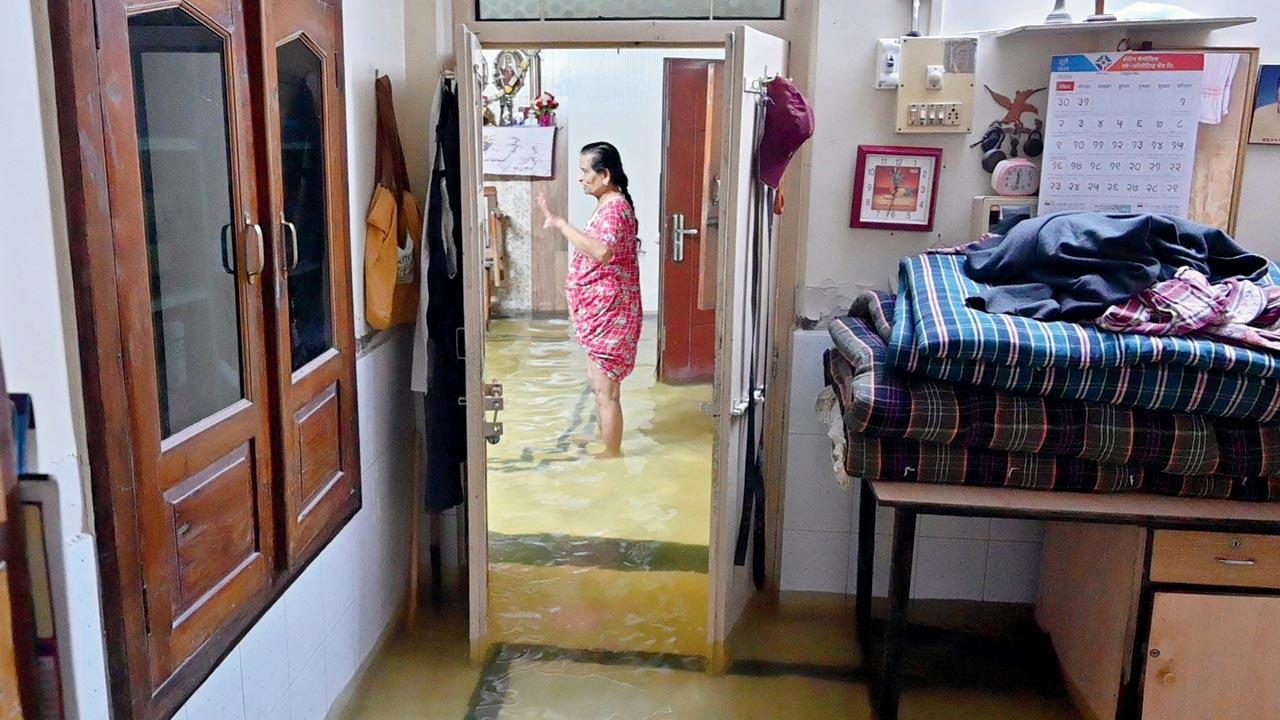
Eighty two-year-old Chulne village resident Teresa D’Sa stands in ankle-deep water. She and her husband moved out of their bungalow after the ground floor flooded. She says that new construction activity in the area has led to an increase in flooding incidents during the monsoon since 2018. Pic/Hanif Patel
In 2017, when urban anthropologist George Jose submitted his PhD thesis titled, Forging a Periphery: Urban transformation in the Mumbai Metropolitan Region, Vasai-Virar was still a year away from experiencing its worst nightmare since the turn of the century. “The unprecedented growth has catalysed attention on the unpreparedness of state agencies and the inadequacy of urban amenities,” Jose had written in the introduction. He wasn’t off the mark. In July of 2018, as the MMR was hit by torrential rain—on July 10 the region received 240 mm rain—the Vasai-Nalasopara-Virar belt saw severe flooding, forcing authorities to call the National Disaster Response Force (NDRF), the Indian Navy, the Army and the Coast Guard along with the Railway Protection Force to carry out rescue work. Thousands were stranded, homes were submerged, and drinking water and electricity were interrupted for five days straight.
ADVERTISEMENT
Last week, memories from that time returned to haunt the residents, after the region received an average of 160 mm rain between July 20 and 22. Social activist Milind Chavan, who we meet in Vasai West days later, says, “The gods have been kind. Imagine what would happen if we got 400 mm rain one day,” he says. “All of Vasai and Virar would drown.”
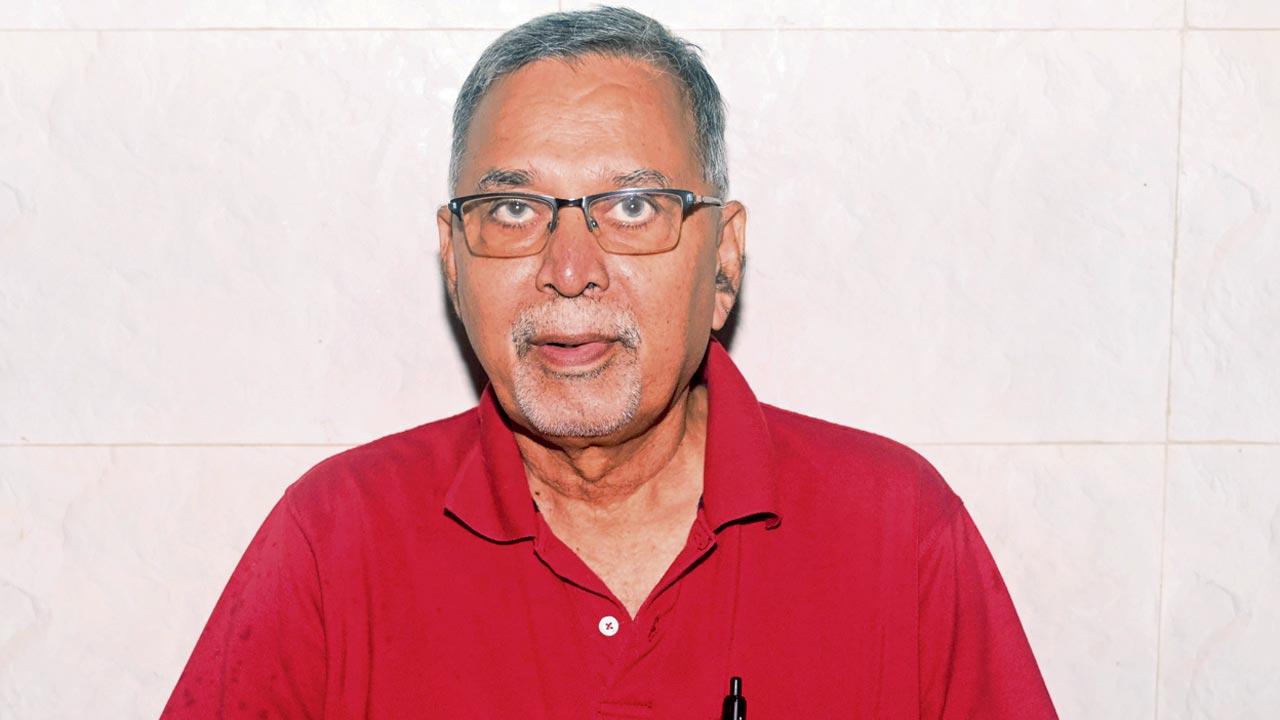 Ashok Grover, chairman, Gowalis Industries Association (GIA)
Ashok Grover, chairman, Gowalis Industries Association (GIA)
The region’s making, unmaking and current state is being attributed to the rapid migration, and industrial and real estate development. In his thesis, Jose highlights how Vasai-Virar, which is less than 50 miles north of the city of Mumbai, used to be an intricate network of villages. “Its economy was predominantly agricultural, with significant sections of its population also engaged in fisheries, and sea-related occupations.
Until recently, adivasis constituted a significant proportion of the total population. All the four important adivasi communities—Warlis, Thakurs, Kolis and Katkaris—were well represented in the region especially in junglepatta [hills section] and kinaarpatta [coastal belt],” he wrote.
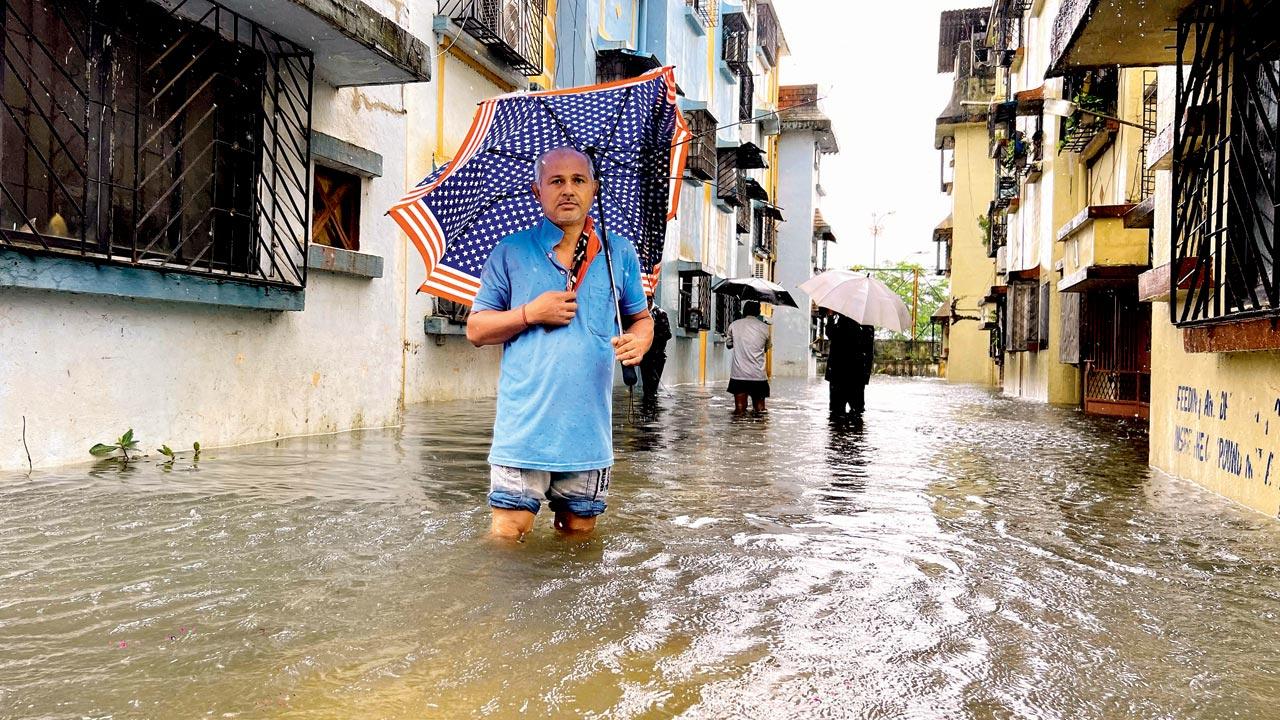 Ground floor residents of Gokul Aangan in Vasai West have to deal with water entering their homes, each time there’s a heavy shower. Water hasn’t receded from their houses in over two weeks. Pics/Hanif Patel
Ground floor residents of Gokul Aangan in Vasai West have to deal with water entering their homes, each time there’s a heavy shower. Water hasn’t receded from their houses in over two weeks. Pics/Hanif Patel
The 1871 Census of Thane district—of which Vasai-Virar is a part—recorded that 91.62 per cent of the district was home to adivasis, who were rapidly dispossessed of their land, especially post the inauguration of the Bombay Baroda & Central India (BB&CI) Railway in the 1860s.
Speaking to mid-day, Jose, who is a visiting associate professor of anthropology at the New York University in Abu Dhabi, says his decision to situate his thesis in the region was spurred by the changing migratory patterns. “In the 1960-70s, Mumbai saw migration from the south of India, but that began to gradually wane in the 1980s and ’90s, where more people were coming in from the north and east of India. Today, a large number of migrants are from Uttar Pradesh and Bihar,” he says over a call. “When, as part of my research, I began to meet some of these contemporary migrants, who worked in the city and considered themselves Mumbaikars, I realised that a lot of them commute daily from Vasai, Nalasopara and Virar.” The focus of Jose’s research was how migration is a fuel for urbanisation.
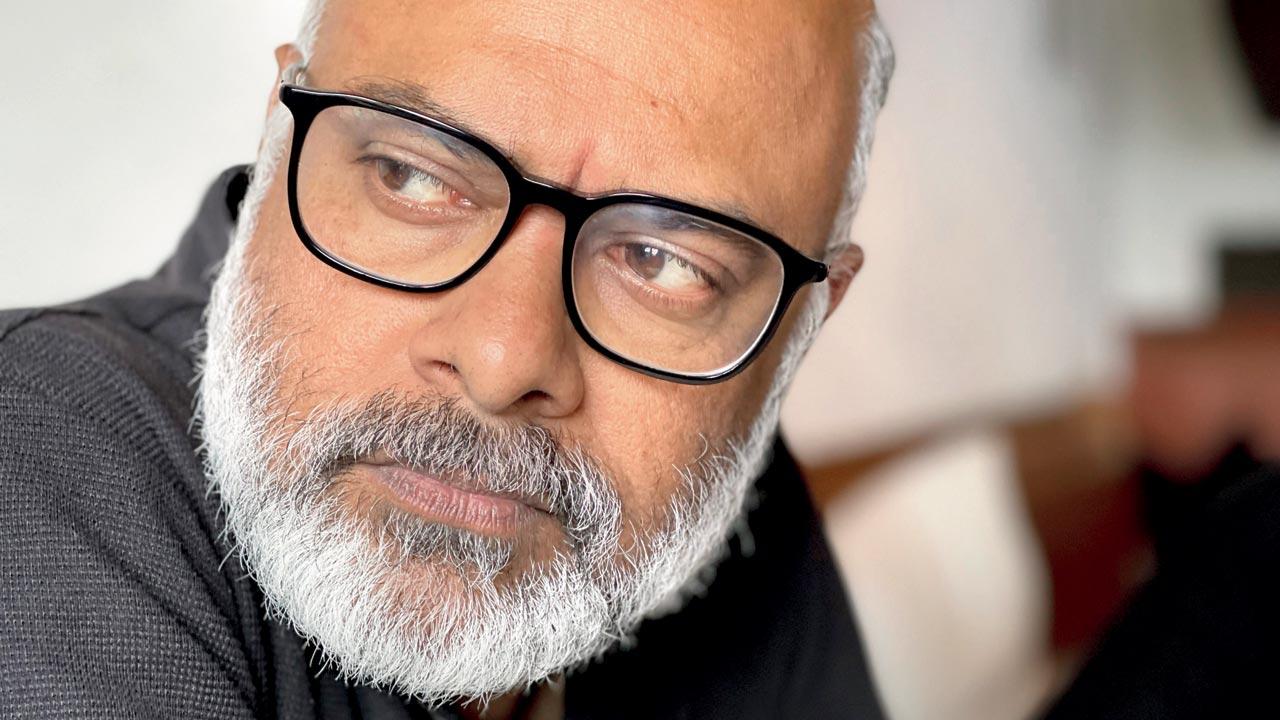 George Jose, urban anthropologist
George Jose, urban anthropologist
Quite early on, one of his interviewees told Jose, “Nalasopara toh gareebon ka sahara hai [Nalasopara is a refuge for the poor]”. “The new poor, unlike the old poor, could not find a place in Mumbai and turned to Vasai and Virar,” he says. It soon became the labour city for Mumbai. The development that took place to accommodate these migrants fuelled tensions between those who were slowly becoming the overwhelming majority and the locals, mostly from the East Indian community. And not
without reason.
The urbanisation has been indiscriminate, haphazard and uncontrolled. “If you see the planning documents of the region from the 1960s, you’ll see salt pans, and next to them, the ponds and lakes, which were integral to the monsoon economy of the region,” says Jose. In general, he feels, we aren’t paying attention to the sustainable future of our cities. “Vasai-Virar is a classic example.”
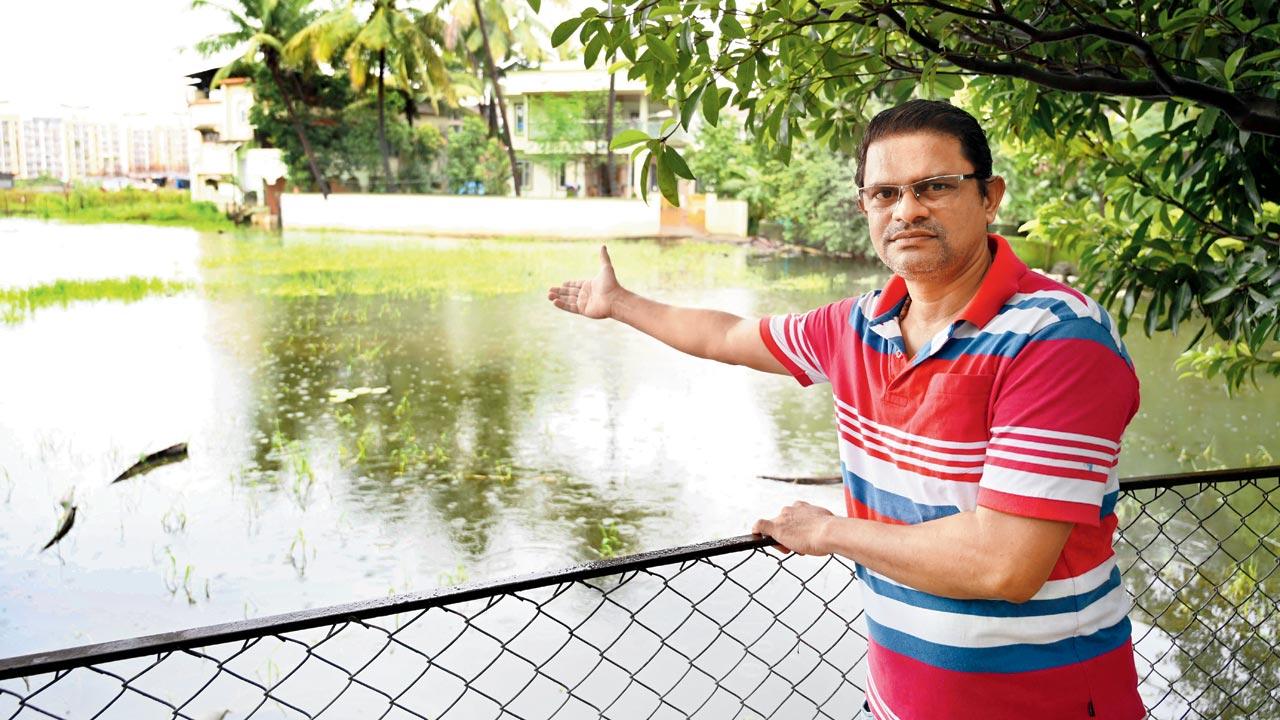 Sebastian Assao, resident of Chulne village in Vasai West, says after the development of a residential complex in the vicinity, flooding events increased in the village. “All the natural outlets for rain water have been dumped with debris or mud; rain water now lies stagnant.” Most villagers have even stopped cultivating rice on their farmlands due to the annual water-logging
Sebastian Assao, resident of Chulne village in Vasai West, says after the development of a residential complex in the vicinity, flooding events increased in the village. “All the natural outlets for rain water have been dumped with debris or mud; rain water now lies stagnant.” Most villagers have even stopped cultivating rice on their farmlands due to the annual water-logging
On July 3, 2009, the Government of Maharashtra issued a notification to merge the four municipal councils of Vasai, Virar, Nalasopara and Navghar-Manickpur, along with 53 adjoining villages, under the newly decreed Vasai-Virar City Municipal Corporation (VVCMC). While this brought the city of Vasai-Virar into existence, 49 villages opposed the state’s order as they wanted to continue being governed by the gram panchayat. The case is still ongoing in the court. The apathy towards the plight of villagers during the monsoon months hasn’t helped the case of the administration.
Chulne, an East Indian Christian village in Vasai West, is a 10-minute drive from the railway station. All of last week, the village was submerged, with residents forced to wade through waist-deep water. When we arrive at Sebastian Assao’s home, the water has just begun to recede after days; the compound they share with a relative still has inches of water. Assao takes us to the back of his home, which a few days earlier, was blocked by slush. A few hundred metres away, separated by a patch of farmland that’s still submerged in water, is a newly constructed residential complex. “This is the cause of the flooding,” he tells us. “A lot of construction activity is taking place. All the natural outlets for rain water have been dumped with debris or mud; rain water now lies stagnant.” Most villagers, including Assao, have stopped cultivating rice on their farmlands due to the yearly water-logging.
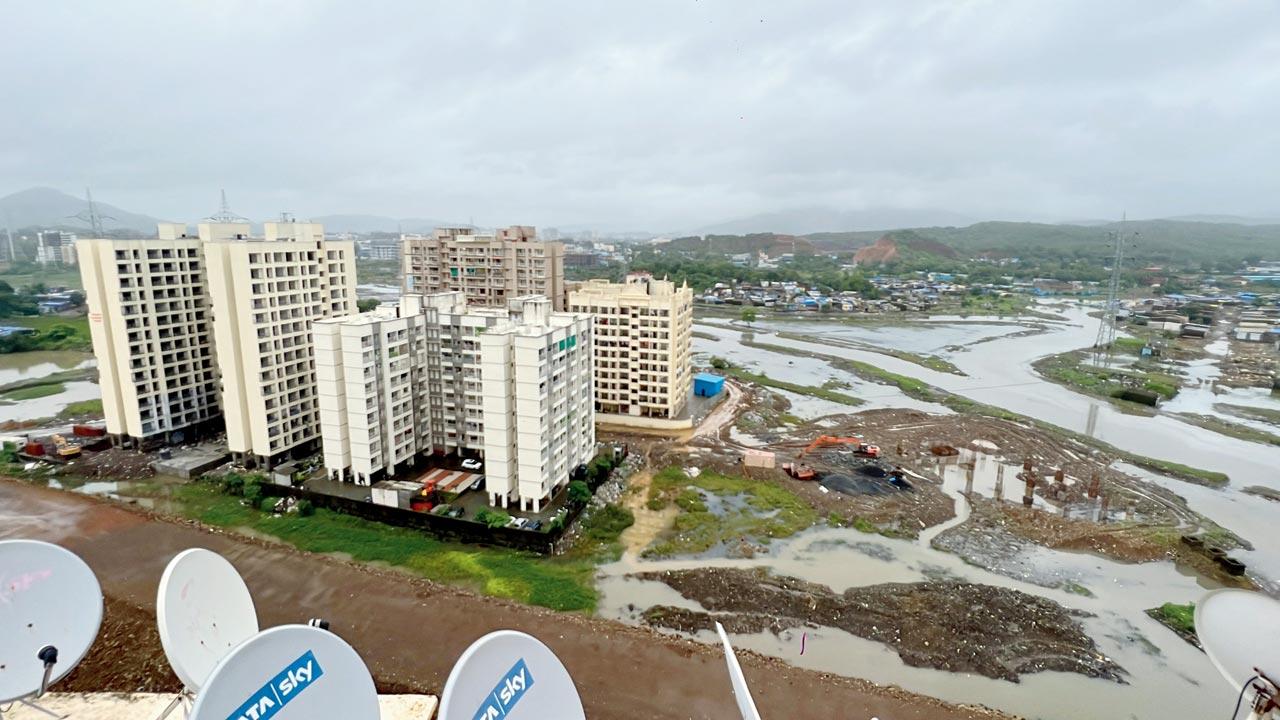 Vasai-Virar continues to draw real estate developers who are steering its urban transformation, with little regard for the environment
Vasai-Virar continues to draw real estate developers who are steering its urban transformation, with little regard for the environment
According to him, until 2005, the village never saw flooding. This year, he decided to house his bed-ridden father on the first floor of their home. Post the devastation of 2018, some villagers, like Tyson D’Costa’s family, have had to take loans to rebuild their bungalows at an elevation. D’Costa’s father is a contractual worker at the VVCMC. “We took a loan of R20 lakh, emptied out our savings, and sold our agricultural land to build the house,” D’Costa says. And yet, water entered their home this season.
Last Thursday, Godson Rodrigues of Aamhi Gasskar Sanghatna, led an agitation at Gass village in Vasai taluka to protest against the water logging. “Every time there’s heavy rainfall, our village is cut off for a few days. We can’t go to work, and our children are forced to stay at home,” says Rodrigues, adding, “We have handed a written request to the tehsildar, and have been assured that the VVCMC municipal commissioner will head a survey in our village to look into the issue.”
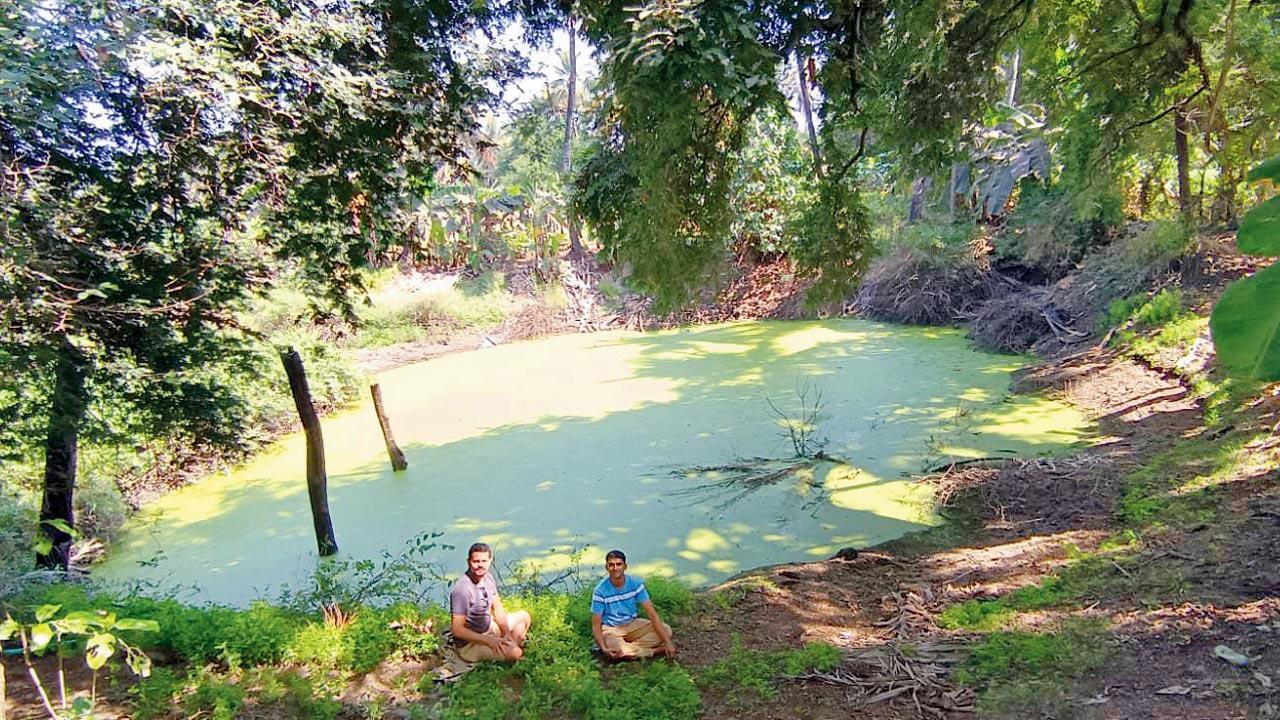 Sachin Marti (in blue), a resident of Bhuigaon, near Nalasopara, has been leading a movement to protect and preserve the local water bodies called bavkhal, which are 200-year-old manmade water systems that help recharge the groundwater. The bavkhal also acts as a natural flood-control system
Sachin Marti (in blue), a resident of Bhuigaon, near Nalasopara, has been leading a movement to protect and preserve the local water bodies called bavkhal, which are 200-year-old manmade water systems that help recharge the groundwater. The bavkhal also acts as a natural flood-control system
Sachin Marti is a resident of Bhuigaon, which sits between Vasai and Nalasopara. An alumnus of Tata Institute of Social Sciences, Marti, for over a decade, has been leading a movement to protect and preserve the local water bodies called bavkhal, which are 200-year-old manmade water systems that once nurtured and protected the coastal wadis of Vasai-Virar. The conservation effort first took off as part of a fellowship from TISS, where he was pursuing a Masters in Social Work, and EdelGive Foundation. “Bavkhals were created for irrigation purpose, but while studying about it, I learnt that they helped recharge the groundwater too, since they served as a natural aquifer.” While the villages are part of the VVCMC, they still do not have municipal water supply and rely on groundwater for daily use and drinking. “It also functioned as a natural flood-control system,” he adds.
While block-level authorities who surveyed 27 villages of Vasai-Virar in 2007 identified 479 bavkhals in all, Marti and his team, as part of the pilot study, discovered 41 bavkhals in Bhuigaon alone. “We conducted a similar survey in six villages, and have found 347 bavkhals... there are bavkhals in other villages that have been unaccounted for. There should be over 800 of them in the entire region,” says Marti, who has begun work on preserving eight such bavhkhals through desilting drives. According to him, most of these have been filled up and concretised due to rapid urbanisation. “The new constructions that have come up, have also diverted septic water into these ponds.” He says, the biggest problem is that the local administration is not ready to accept that bavkhal is a water body. “Why is no effort being made for their preservation?”
 Milind Chavan, local activist
Milind Chavan, local activist
Like villages, residential complexes are also victims of negligence by authorities. Suncity in Vasai West abuts vast acres of wetlands, which sees pink flamingos during the migratory season. Suncity is home to 33 societies, with approximately 12,000 residents. Nikhil Kamdar, secretary of the Shri Chintamani Cooperative Housing Society at Suncity, and member of the Suncity Public Welfare Association (SPWA), says that the market rate of a 3BHK flat in his society is anywhere between Rs 1.10 to R1.15 crore. “We recently sold a 2BHK for R98 lakh,” says Kamdar. Yet, during this year’s rains, the area was submerged, and people couldn’t step out of their home. “Neither a car nor bike could get out,” adds Kalpesh Mehta, who is also a member of the SPWA. “It was worse during the 2018 floods, with the fire brigade having to come here, and provide water to us. We also didn’t have electricity for three days,” he recalls.
Residents here have been feeling the pinch. One of them, on condition of anonymity told mid-day, that his wife has been trying to convince him to sell the flat at Suncity and move out. “We are done with Vasai!” he says.
 The Suncity Gass Road in Vasai West, which is surrounded by wetlands on either side, is seen submerged in last week’s downpour. The road connects residents of Suncity with the rest of Vasai. During heavy rains, residents are completely blocked out, and are unable to take their cars or bikes out
The Suncity Gass Road in Vasai West, which is surrounded by wetlands on either side, is seen submerged in last week’s downpour. The road connects residents of Suncity with the rest of Vasai. During heavy rains, residents are completely blocked out, and are unable to take their cars or bikes out
Ground floor residents of Gokul Aangan in Vasai West too, are a distraught lot. On online real estate platforms, Gokul Aangan has been described as an elite project with impeccable modern amenities. The going rate for a 2BHK there is R47 lakh. But the scenes in the residential complex were distressing after Thursday and Friday’s rains. Prakash Babulal Chaudhary, who moved with his family from Thane to Vasai in 2009, says the monsoon is a harrowing time for them. Each time there’s a heavy shower, water enters their ground-floor home. “We used to live in a jhopdi in Thane, and got this home for just R16 lakh. For the first eight
years, there was no problem at all.” After 2017, he says, the township would be water-logged every monsoon. Once the water enters, it takes days to recede. His wife, Indu Prakash Chaudhary, breaks down. “My son, daughter-in-law and five-year-old grandson are temporarily living elsewhere, because it’s dangerous to live in this condition. He [my grandson] could pick up an infection.”
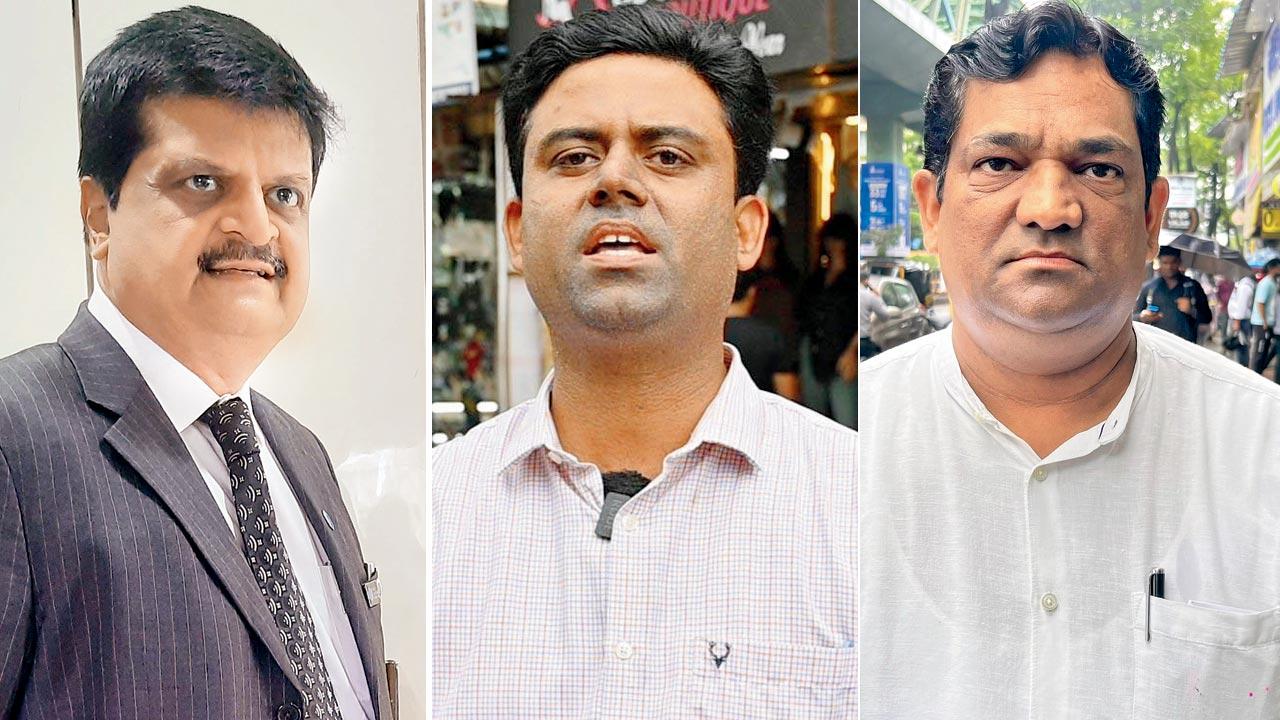 Dhiren P Doshi, Mecanzy Dabre and Sameer Subhash Vartak
Dhiren P Doshi, Mecanzy Dabre and Sameer Subhash Vartak
Local activist Milind Chavan claims that the blocking of the Sopara creek by authorities has caused water-logging in Gokul Aangan. “Water from Sopara creek flows from the west and meets Rajavali, from where it flows to Naigaon and then Bhayandar,” says Chavan. Right opposite this creek is another channel, carrying waste water from Navghar-Manikpur, which also flows into Rajavali. “Some years ago, VVCMC built a garden and a road across these two waterways, blocking and diverting their paths.” During heavy rain and high tide, water from the Sopara creek would swell and enter the residential zones. “Today, a pump has been installed to divert water from Navghar-Manikpur to Rajavali,” says Chavan.
A real estate builder, on condition of anonymity, said that most builders have been forced to come up with their own drainage system, to deal with the ongoing problem. Sebastian Assao of Chulne says that builders think of setting up drainage lines only as an afterthought. “For them, the focus is building complexes and selling the flats.” According to local journalist Pravin Nalawade, the sewage system in Vasai-Virar hasn’t been repaired in years.
 Godson Rodrigues, Pravin Nalawade and Tyson D’Costa
Godson Rodrigues, Pravin Nalawade and Tyson D’Costa
Since the 1990s, the Vasai belt has been drawing industries by the dozen. “Vasai’s proximity to the highway and Mumbai city, and cheaper land options have led businessmen to choose Vasai to set up industries. Most of them are first generation entrepreneurs,” says Ashok Grover, chairman of Gowalis Industries Association (GIA), who established his own factory in 1987. Today, Vasai has over 13,000 industries, many of which are engineering and electronics units. “But these industries came up in a haphazard manner. That’s because earlier this region was run by gram panchayats; thereafter, CIDCO [City and Industrial Development Corporation] took over, after which the municipal corporation came into being. Different authorities meant different sanctions. I know many industries that have come up on nullahs, because they got clearances from the local gram panchayat.”
This poor town planning didn’t help the industries either. Grover says there is no drainage system in the industrial area. “Whatever exists is also defunct. This leads to extreme water-logging during heavy showers.” The Golani industrial area, he says, is most affected. “There’s also a river that passes our area, which flows down from the Tungareshwar mountain into the sea. Desilting of this river is never done.” During last week’s rain, the industries were shut for three days. “Crucial man hours were lost. The daily wage workers are worst hit.” According to him, the industries in Vasai are contributing over Rs 2,000 crore annually as GST to the government. “This industrial belt is also giving the highest revenue to the MSEB [Maharashtra State Electricity Board]. Despite that, we are still struggling for basic amenities.”
In 2018, VVCMC had roped in the National Environmental Engineering Research Institute (NEERI) and Indian Institutes of Technology-Bombay to survey the Vasai-Virar belt, and understand what caused the floods. The report titled Vasai-Virar Flood Modelling and Mitigation Study, which was submitted a year later, listed detailed plans for work to be undertaken at various nullah stretches across the region, which included desilting, desludging, widening, cleaning all of water passages for free flow, and creating holding ponds to store water. Sameer Subhash Vartak, activist and president of the environment department of the Maharashtra Pradesh Congress Committee, says, “It has been almost four years, but no work has been done.” Vartak says that the IIT and NEERI survey suggested creating eight holding ponds, and the VVCMC also distributed Rs 300 crore as transferable development rights to acquire land for the holding ponds, but work is yet to begin. Environmentalist and local activist Mecanzy Dabre adds, “If these holding ponds come up, we won’t see this kind of flooding.”
This writer spent between last Thursday and Saturday trying to elicit a comment from VVCMC commissioner Anilkumar Pawar, hoping he could throw light on the issue. After his office promised to get back with a comment, we continued to try reaching him; our calls to him went unanswered or were disconnected.
Despite the apprehensions about Vasai-Virar drowning, Dr Mohit Ramsinghani, chief of sales, Runwal Group, one of the top real estate developers in the city, says that the region has potential.
“With the upcoming infrastructure projects planned by the government, Vasai-Virar will enjoy better connectivity and reach. The current real estate price points are very lucrative, making home buyers get larger and spacious homes away from the hustle bustle of the city in midst of the nature, with the advantage of connectivity to the city,” says Ramsinghani. Among the many upcoming projects, he says is the Virar-Mira Road metro line and Vasai-Versova Sea Link, which will reduce commute time from Virar to Nariman Point. “Virar is also one of the 12 proposed stations for the Mumbai-Ahmedabad bullet train, this will drive robust infrastructure growth for the location. The 126 km Virar-Alibaug multimodal corridor will create economic opportunities and residential growth for the location, and the Delhi-Mumbai Industrial corridor will open key trade industries for Virar.”
Property consultant Dhiren P Doshi, who heads Dhiren Estate Agency, says the current issues plaguing Vasai-Virar are not putting off buyers, though they are wary. “It’s still one of the more affordable pockets in the Western region, with train routes originating from both, Vasai and Virar,” says Doshi adding, “Also, you have really posh residential towers coming up in these regions, with top-class infrastructure, and at less than half the price of flats in Borivli and Malad [just 20-25 minutes from Vasai-Virar].” At present, homes are going for anywhere between Rs 4,000-7,000 per sqft on the carpet. Borivli, on the other hand, is Rs 23,000-Rs 35,000 per sqft. The boom in flat sales began in 2011. “It’s mostly the middle-class buying flats here,” he says. Doshi, however, feels that there is a need for authorities to slow down construction activity in the region and focus on town planning. “Many buyers are concerned,” he says, “I feel both the municipality and developers need to work together to resolve the issue. If they want these flats to sell, they have no other option.”
With inputs by Hanif Patel jane.borges@mid-day.com
Rs 1.10cr
Approx value of 3BHK in Suncity, Vasai W. Last week, approach road to this complex of 12k residents went invisible under water
Rs 2,000 crore
Approx amount the industries in Vasai-Virar belt are contributing annually as Goods and Services Tax (GST) to the government
 Subscribe today by clicking the link and stay updated with the latest news!" Click here!
Subscribe today by clicking the link and stay updated with the latest news!" Click here!








